Jump into a ditch and ... wait quietly - this is one of the advice given to US citizens half a century ago in the event of a nuclear attack. What were the US civil defense programs like in World War III? And could they help anyone at all?
The destructive force that razed the Japanese cities of Hiroshima and Nagasaki to the ground in 1945 stunned the world. To this day, it is a grim warning not to use nuclear weapons for military purposes. Even so, the people responsible for carrying out the attack did not suffer any consequences, and their act was hailed in the media as a "necessary evil" to end the war.
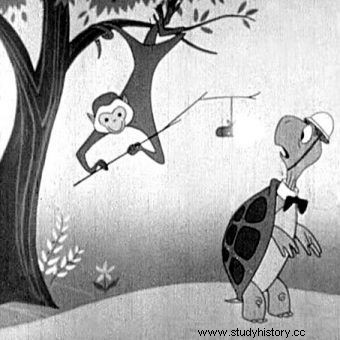
For the youngest citizens, the American government has prepared an instruction in the form of a cartoon about the lovable Berta turtle called "Duck and cover".
In later years, American politicians treated the specter of the nuclear conflict as another string to pull and control the frightened society, competing in creating civil defense plans in the event of bombing. Here are some examples of "good advice" that nuclear holocaust survivors had to offer Americans ...
The goat remained unmoved
First of all, one thing must be said - experts were well aware from the very beginning that any strategy in the event of a nuclear attack would not make much sense anyway. But they couldn't just tell the citizens that. As we read in Rodric Braithwaite's book, Armageddon and Paranoia. Cold War - Nuclear Confrontation ”:
After Hiroshima, people learned that a new world war could kill tens of millions of lives. Governments realized that any defense plans would be too costly and presumably would do little to help. However, they could not afford to accuse themselves of not taking responsibility for anything.
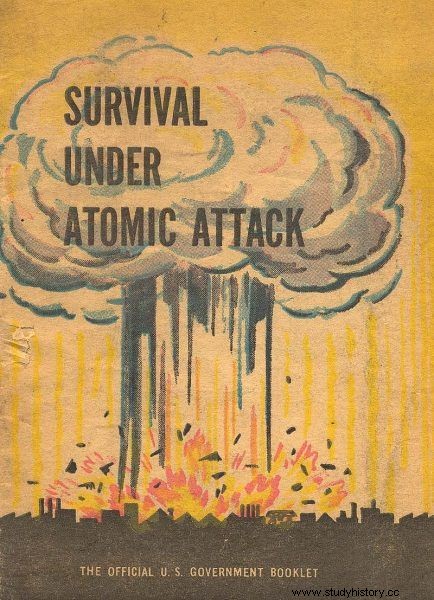
A nuclear war survival manual for adult citizens, published in 1950 by the US government.
It all boiled down to properly conducted policy. In conjunction with a variety of civil defense programs, the state promoted "education" about nuclear bombing to soothe citizens' shattered nerves. According to information provided by psychiatrists (or rather politicians such as Dale Cameron, then deputy director of the National Institute of Mental Health), the worst threat - apart from the attack itself, of course - was ... fear, which in turn was supposed to lead to a breakdown. And this could not be allowed, because the spirit in society and the will to fight the enemy are the most important.
At that time, Cornell University even conducted research to determine people's vulnerability to breakdown and panic. Project scientists found that the governing mechanisms of Homo sapiens in an emergency, it can be known from the behavior of… goats placed in similar situations. They relied, inter alia, on the recording of the nuclear test at Bikini Atoll.
The video showed an animal positioned within sight of the explosion site. The goat did not seem particularly concerned with the outbreak, calmly chewing her food and not panicking. So the researchers concluded that people would certainly have done the same. There was nothing else to do but to make the citizens of the United States aware that in the face of a nuclear war they should act like the said goat.
They immediately got to work. For example, the Truman government published a booklet with the optimistic title "Surviving an Nuclear Attack," which read that to survive a bombing, all you had to do was jump into a ditch, not leave flammable debris near buildings, and take your time to go outside. The publication also "denied" "myths" that a nuclear war could destroy the Earth, and the radiation was deadly at long distances.
Bunker fashion
Compared to the British and the Russians, who had experienced the war, the people of the United States did not know exactly what they were dealing with. In their minds, the vision of the bombing was very vague. The average citizen did not realize what destruction, fear and loss of people were caused by "ordinary" bombs so it was not difficult to convince them that the effects of a nuclear warhead explosion are not much different from them.
That is why many Americans believed that a bigger bomb would be enough… a bigger shelter. This conviction was fueled by ubiquitous posters and cartoon brochures in newspapers, declining "false" information about the power of bombs and lethal radiation. Tours were even organized where participants could go to the vicinity of the site where the nuclear weapons were tested for the cost of three dollars. According to the advertising material, the spectacular view could be seen from a safe bunker 65 miles northwest of Las Vegas all week except Sunday.
In 1946, the United States also suggested a massive federal program to build shelters. However, the idea met with a wave of - anyway justified - criticism. After all, it was not possible to erect protective structures for all citizens. So it was decided to refer to ... the American character. Why shouldn't people build their own shelters? In his book "Armageddon and Paranoia", Rodric Braithwaite relates:
Enthusiasts of this idea thought it would have great psychological benefits. A homeowner would feel proud to have a self-built shelter. This would neutralize unrest and reinforce the impression that "we can indeed do something about this". But there was a catch. Not everyone could afford to build their own shelter. There was, of course, the political risk that it might be taken as if it were being divided between those who would be saved and those who would not be saved.
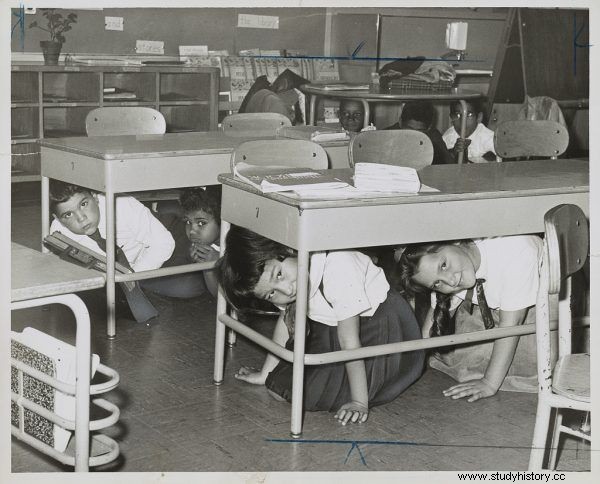
American children were convinced that in the event of a nuclear war, it would be enough to ... hide under a school desk.
In view of the unsolved problem, the officially accepted way to save the civilian population was ... evacuation outside the city. It didn't take long, however. After large-scale trials and successive waves of criticism from the world of science, the shelters were again turned - even though they also did not find approval among scientists, whether or not they were planned by President Nixon in the 1950s, Kennedy in the 1960s. or Reagan in the 80's.
The renowned economist Kenneth Galbraith had the opportunity to look at a project drawn up by the Kennedy government. It did not make a good impression on him. The presidential advisor harshly criticized the clear division between the poor and the rich, saving the republicans at the expense of the democrats , and - above all - the fact that the survivors of the bombing would see a world full of human bodies without food, water and transport.
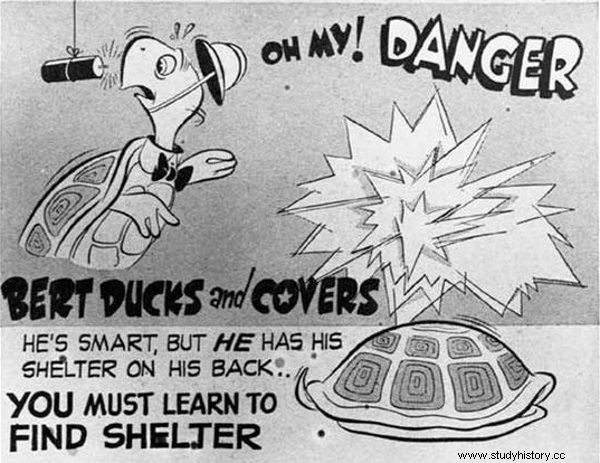
photo:US gov / public domain The propaganda film "Duck and Cover" has become a symbol of the Cold War across the ocean.
Meanwhile, deaf to the sobering voices of scientists, populists continued to propagate their views. It even got to the point where a columnist for America postulated that "it is ethically acceptable to shoot neighbors trying to break into your fallout shelter."
Ultimately, it turned out that all the grand projects were worth about as much as the words of Thomas K. Jones, a Defense Department official. The one, in 1982, announced:"If there are enough shovels for everyone, everyone can handle it. Dig a hole, cover it with a couple of doors, put a meter of soil on it. It is the earth that provides protection. Let's do it right and America will recover from a nuclear war in two or three years. " Today every child knows how pious those wishes were…
To be like a turtle
In those days, however, also the youngest were fed with propaganda mush. Even instructional animations have been created for the use of American children. Best known, with the telling title "Duck and cover" (literally "Get Down and Hide"), featured a cartoon turtle. His name was Bert and he knew perfectly well how to avoid the bomb. Thus, in schools, children practiced, following the example of a brave animal, hiding under a bench, in a ditch or behind a wall.
Interestingly, experts say that in the case of bombardment with fissile nuclear warheads, the tips from the movie and the booklet "Surviving an Nuclear Attack" could have been quite useful! But it would be useless if the enemy used a thermonuclear weapon.
In 1951, in addition to the film about the Berta the turtle, another was made, with the patriotic title "Our Cities Must Fight", instructing citizens to stay in large urban centers and try to keep the industry running . Another title, produced by the US Air Force, "Let's Face It" in 1954, sustained this tone. But much closer to the truth about the problems plaguing the world during the Cold War was the terrifying, satirical work of Stanley Kubrick from 1964.
Meanwhile, there were even those who unequivocally treated the whole confusion as ... a clever politics. As Rodric Braithwaite writes in Armageddon and Paranoia:
From the outset, some critics have argued that any official programs were deliberately designed to increase fear of the Russians and thus weaken criticism of the policy of deterrence. In June 1955, twenty-eight demonstrators were arrested in New York City for refusing to participate in mandatory civil defense exercises.
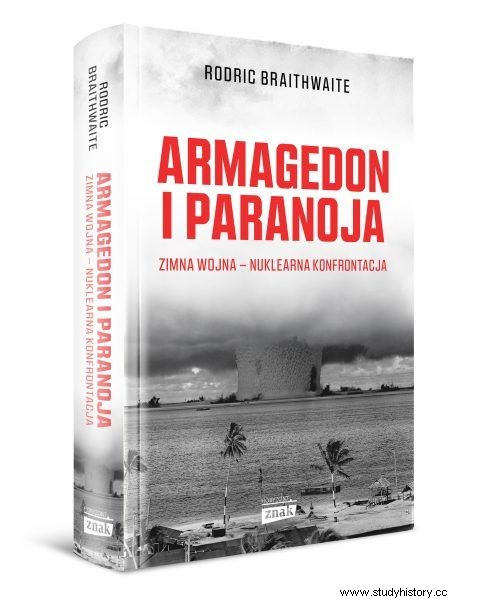
The Justice of the Peace Interviewing them said to the demonstrators that they are "murderers" who "with their actions and behavior contribute to the extermination of these three million people theoretically killed in our city.
The only question is, were they really right? Or maybe the threat actually existed? And if it did exist, should training in defense or rather try to alleviate international tensions?
The facts are disturbing. In 1979, one man's decision was decisive for the fate of mankind. Zbigniew Brzeziński, the national security adviser to President Jimmy Carter, could lose his head and launch a retaliatory procedure after receiving a phone call notifying about the approaching Soviet missiles. This would cause a global conflict on an unprecedented scale, and the world today would be completely different. Perhaps there would be no people on it. However, the information about the attack from Russia turned out to be false - so it was fortunate that Brzeziński delayed issuing the instruction until the last moment.
However, it was close to the outbreak of the Third World War. Methods of protection against nuclear attack were not effective then - and they are not today either. Regardless, the global powers still have a nuclear arsenal, and the harsh truth is that at any time - by one man's decision or mistake - we can all be blown up at once.
